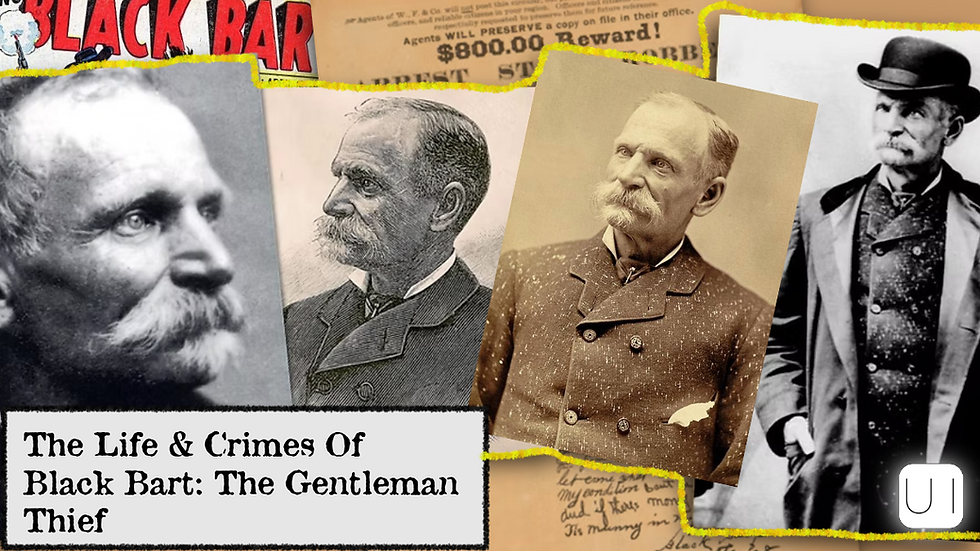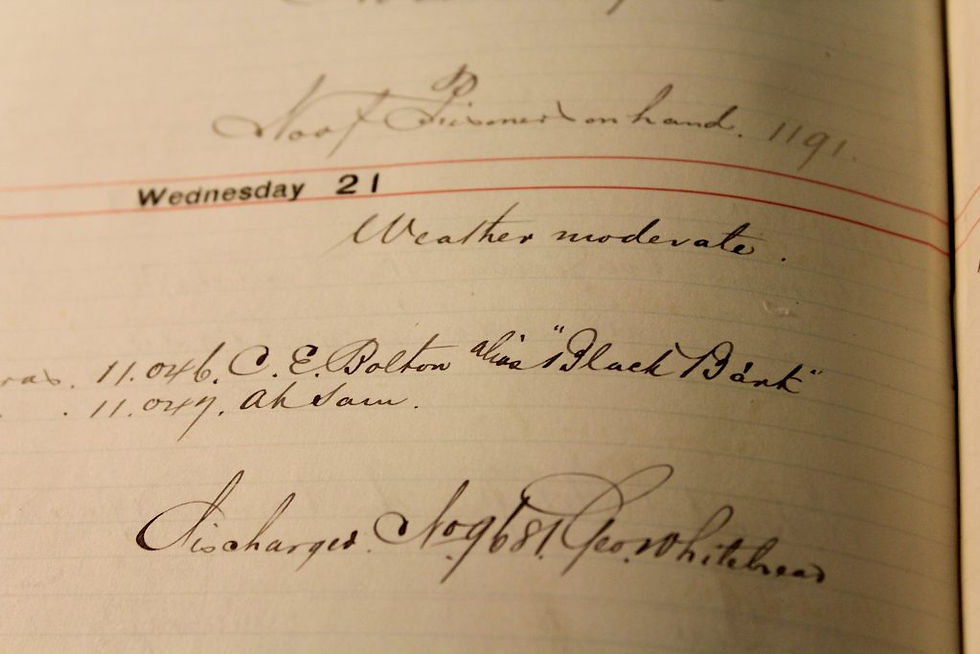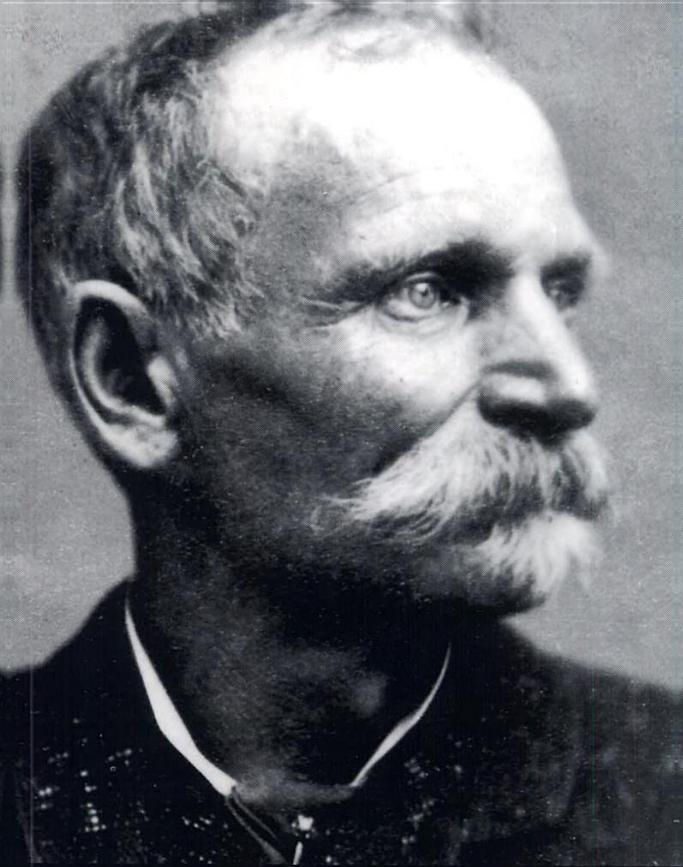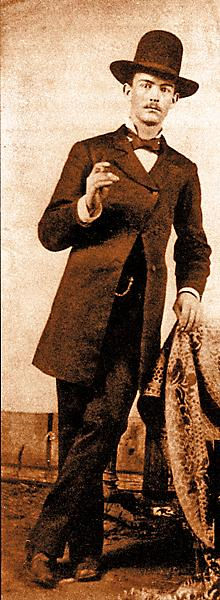Black Bart: The Gentleman Bandit Who Robbed Stagecoaches with Poetry
- Daniel Holland

- Nov 3, 2022
- 7 min read

On 3 November 1883, a Wells Fargo stagecoach climbed Funk Hill in California’s Gold Country. Its driver, Reason McConnell, slowed the horses when a masked figure appeared from behind a boulder. The outlaw wore a long linen duster and a derby hat perched over a flour sack mask with two holes cut for eyes. In his hands he carried a shotgun.
In a calm but commanding voice he spoke the words that drivers across Northern California had come to dread:
“Throw down the box.”
This was Black Bart, the most unusual outlaw of the Old West. Unlike Jesse James or Billy the Kid, he wasn’t a drinker or a killer. He never fired a shot, never swore at his victims, and often raised his hat politely to women. Sometimes, he even left behind poems signed “Black Bart, the Po8.”
But on that day at Funk Hill, his long run of luck ended. A young hunter named Jimmy Rolleri happened to be nearby with a rifle. Shots rang out, the outlaw stumbled away, and in his hasty retreat he dropped a handkerchief with a laundry mark. That small piece of cloth would lead Wells Fargo detectives straight to the man behind the mask: Charles E. Boles, the gentleman bandit of California.
Early life: from Norfolk to New York
Charles E. Boles (sometimes spelled Bolles) was born around 1829 in Norfolk, England, the third of ten children of John and Maria Boles. In 1831, the family emigrated to Jefferson County, New York, settling on a farm north of Plessis Village. Charley, as friends called him, grew up in a large household of six brothers and three sisters.
The lure of gold
Like thousands of young men, Boles was caught up in the California Gold Rush. In late 1849, he and his brothers David and James joined the flood of prospectors in the Sierra foothills, working claims on the North Fork of the American River near Sacramento. They returned east in 1852, but Charles went west again with brothers David and Robert. Both soon died of illness, leaving Charles to carry on alone before abandoning his claim and heading back east.
In 1854 he married Mary Elizabeth Johnson in Decatur, Illinois. By 1860, the couple had four children. Yet Charles was restless, always drawn back to adventure and the promise of gold.
Civil War veteran
On 13 August 1862, Boles enlisted as a private in Company B of the 116th Illinois Infantry Regiment. He proved to be a reliable soldier, rising to First Sergeant within a year.
He fought at the Siege of Vicksburg, where he was badly wounded, and later marched with Sherman on the infamous March to the Sea. By the end of the war, he had received brevet commissions as both second lieutenant and first lieutenant. Discharged in June 1865, he returned to Illinois, carrying the discipline of a soldier but also the trauma of bloody campaigns.
Bart later admitted that his shotgun was never loaded during robberies, he couldn’t bear the thought of more killing after what he’d seen in the war.

Prospecting and a grudge against Wells Fargo
In 1867 Boles went west again to prospect in Idaho and Montana. In an 1871 letter to his wife, he described a bitter encounter with Wells Fargo agents. He felt cheated and humiliated, vowing revenge against the company. It was an anger that would soon fuel one of the strangest outlaw careers of the 19th century.
Enter Black Bart
By 1875, Charles Boles had transformed into Black Bart, a polite, literate, and strangely theatrical stagecoach robber. His style was unique:
A long linen duster coat
A bowler/derby hat
A flour sack mask with eyeholes
A double-barrelled shotgun (unloaded)
A gentlemanly manner—no swearing, no drunkenness, no unnecessary cruelty
He was also afraid of horses, which meant he fled on foot after every robbery. Unlike other outlaws who relied on gangs, Bart always worked alone, bluffing drivers into believing gunmen were hiding nearby.
First robbery: 26 July 1875
His debut came on the road between Copperopolis and Milton, Calaveras County. He stopped stage driver John Shine, ordering him to “throw down the box.” To add menace, he called into the brush: “If he dares to shoot, give him a solid volley, boys!”
Shine, seeing what appeared to be rifles aimed at him, surrendered. Later inspection revealed the “gunmen” were sticks tied to branches. The take was modest, just $160 (about $5,200 today), but the performance was flawless.
A catalogue of robberies
Over the next eight years, Bart robbed at least 28 confirmed stagecoaches in California and Oregon. His favourite hunting grounds included:
The Sonora–Milton road (Calaveras County)
Routes between North San Juan and Marysville
The Point Arena to Duncans Mills stage (Mendocino and Sonoma Counties)
The Quincy–Oroville line (Plumas and Butte Counties)
The Ukiah–Cloverdale run
The Yreka–Redding stage (Shasta County)
Interstate routes along the Siskiyou Trail into Oregon
Passengers often recalled his deep, resonant voice, his “intellectual” conversation, and his oddly polite humour. Fourteen-year-old Donna McCreary, who once saw him up close, described him as greying, missing front teeth, with piercing blue eyes and slender hands.

The poet of the Sierra
Bart became famous not just for his robberies but for the verses he occasionally left behind.
Poem #1 – 3 August 1877, Point Arena to Duncans Mills:
I’ve labored long and hard for bread,
For honor, and for riches,
But on my corns too long you’ve tread,
You fine-haired sons of bitches.
Poem #2 – 25 July 1878, Quincy to Oroville:
Here I lay me down to sleep
To wait the coming morrow,
Perhaps success, perhaps defeat,
And everlasting sorrow.
Let come what will, I’ll try it on,
My condition can’t be worse;
And if there’s money in that box’Tis munny in my purse.
Though he only wrote two authenticated poems, it was enough to earn him the nickname “Black Bart, the Po8.”
The Wells Fargo problem
By the late 1870s, Bart was the bane of Wells Fargo. The company issued reward posters, and its chief detective James B. Hume made it his personal mission to capture him.
Bart taunted Hume, sometimes sending greetings after robberies. He stole thousands of dollars in gold and mail, often disappearing without a trace. Wells Fargo’s reputation was at stake—how could such a courteous thief outwit them again and again?
Funk Hill: the final robbery
On 3 November 1883, Bart returned to Funk Hill, the site of his very first holdup. This time, driver Reason McConnell had an armed passenger nearby: Jimmy Rolleri, a 19-year-old hunter with a Henry rifle.

Bart forced McConnell to unhitch his team before wrestling with a bolted-down strongbox. As he carried it away, McConnell and Rolleri fired. Bart stumbled, wounded in the hand, and dropped mail. He stuffed some gold amalgam into a log, discarded his shotgun, and fled.
At the scene investigators recovered his eyeglasses, food, and a handkerchief marked F.X.O.7.
The laundry mark that unmasked him
Detectives Hume and Morse canvassed nearly 90 laundries in San Francisco before tracing the mark to Ferguson & Bigg’s California Laundry on Bush Street. The customer was “C.E. Bolton,” a mining engineer lodging nearby.
Inside his room police found a Bible inscribed from his wife, confirming his true name: Charles E. Boles. He initially gave the alias “T.Z. Spalding” but eventually admitted to several robberies (though only those before 1879, thinking the statute of limitations protected him).
Trial and San Quentin
In 1884, Wells Fargo pressed charges only for the Funk Hill robbery. Bart was convicted and sentenced to six years in San Quentin Prison.
Prison reports described him as witty, enduring, and impeccably polite. He worked in the pharmacy, becoming an able chemist.
Released on 1 January 1888 for good behaviour, he told reporters: “No, gentlemen, I’m through with crime.” Asked if he would write more poetry, he laughed: “Did you not hear me say that I was through with crime?”
The mystery after 1888
After San Quentin, Bart vanished. He never reunited with his wife but wrote letters, saying he felt demoralised and shadowed by Wells Fargo. His last confirmed sighting was at the Visalia House Hotel on 28 February 1888.
After that, rumours spread:
That he moved east under an alias.
That Wells Fargo secretly paid him off.
That he lived quietly in Marysville as a pharmacist.
That he fled abroad, possibly even to Japan.
An obituary for a “Charles Boles” appeared in 1917, but it was never proven.
Copycats and enduring legend
In November 1888, a stage was robbed by a masked man who left behind a poem. Detective Hume compared the handwriting and declared it a copycat.
By then, it didn’t matter. Bart’s legend was fixed in folklore. He was the outlaw who robbed on foot, feared horses, tipped his hat to women, and wrote poetry in the dust of the Sierra.
Legacy of the gentleman bandit
Black Bart stands apart from the usual cast of Old West criminals. He wasn’t a killer or a brawler. His robberies relied on bluff, performance, and a strange sense of style.
Today his story lives on in books, museums, and tourist trails across California. He remains the gentleman bandit of the Sierra Nevada, remembered less for the gold he stole and more for the verses he left behind.
Sources
San Francisco Bulletin, 14 November 1883
Daily Alta California, 23 September 1882
Wells Fargo History – https://www.wellsfargohistory.com
Calaveras Heritage Council – https://www.calaverasheritagecouncil.com
PBS American Experience: The Wild West – https://www.pbs.org/wgbh/americanexperience
James B. Hume Papers, California State Library – https://www.library.ca.gov
Robert J. Chandler, Wells Fargo Detective: The Biography of James B. Hume (University of Oklahoma Press, 2008)
John Boessenecker, Gentleman Bandit: The True Story of Black Bart, the Old West’s Most Infamous Stagecoach Robber (Norman: University of Oklahoma Press, 2008)
Marysville Cemetery Commission, interview with Victoria Tudor (2017)











































































































Comments